Individual Report: IT, Ethical Issues, and Networking Technologies
VerifiedAdded on 2023/01/10
|11
|3375
|79
Report
AI Summary
This individual report delves into the crucial role of Information Technology (IT) in business success and failure, using Iceland, a retail company, as a case study. It explores the impact of IT on productivity, communication, data management, and customer relationship management. The report also examines ethical and social issues, such as discrimination, security breaches, and data privacy, and how these challenges can be addressed within a business context. Furthermore, it differentiates various networking technologies like LAN and WAN and discusses the importance of Intranet and Internet for business operations. Finally, the report outlines the stages of the system development life cycle, providing a comprehensive overview of IT's multifaceted role in modern business practices.
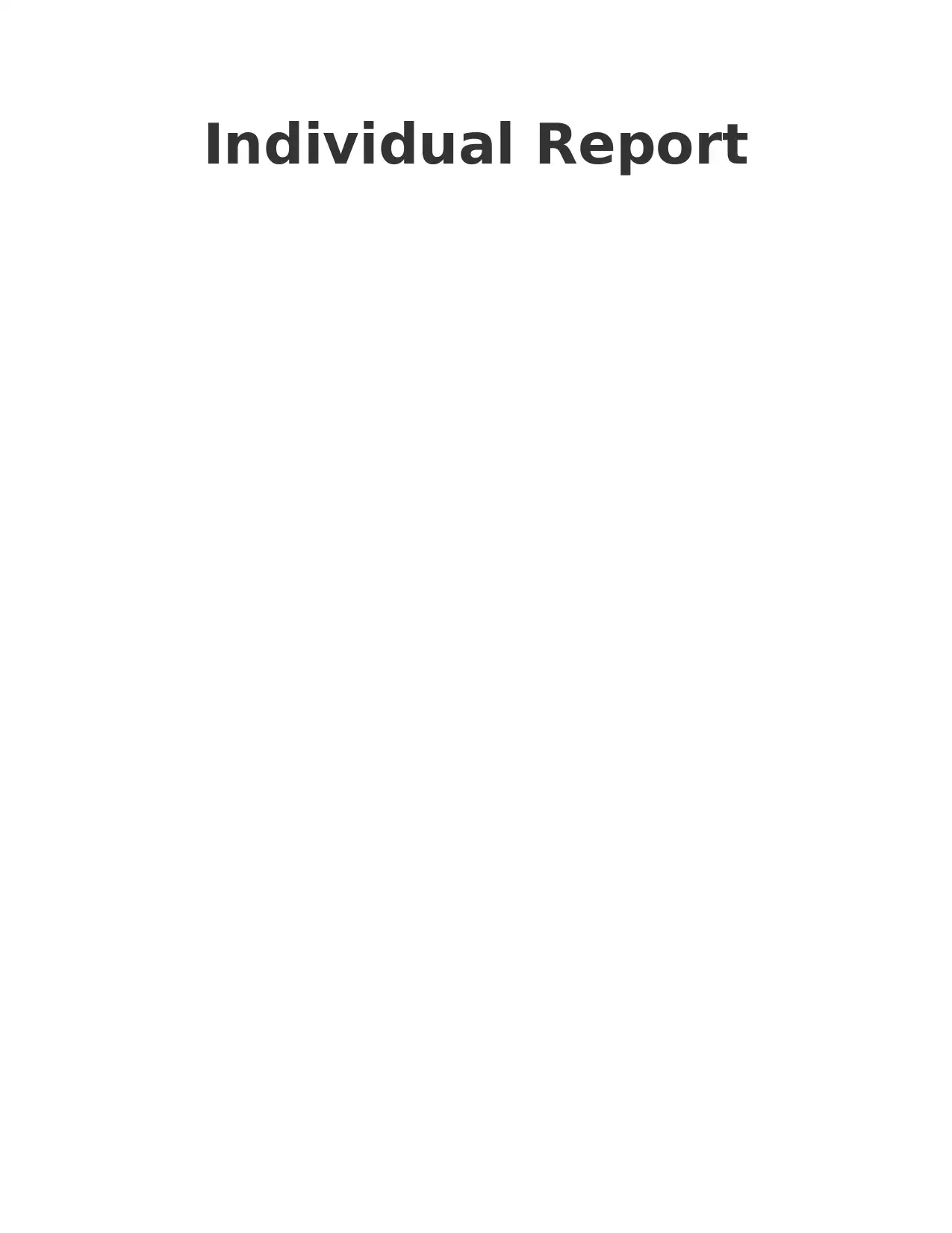
Individual Report
Paraphrase This Document
Need a fresh take? Get an instant paraphrase of this document with our AI Paraphraser
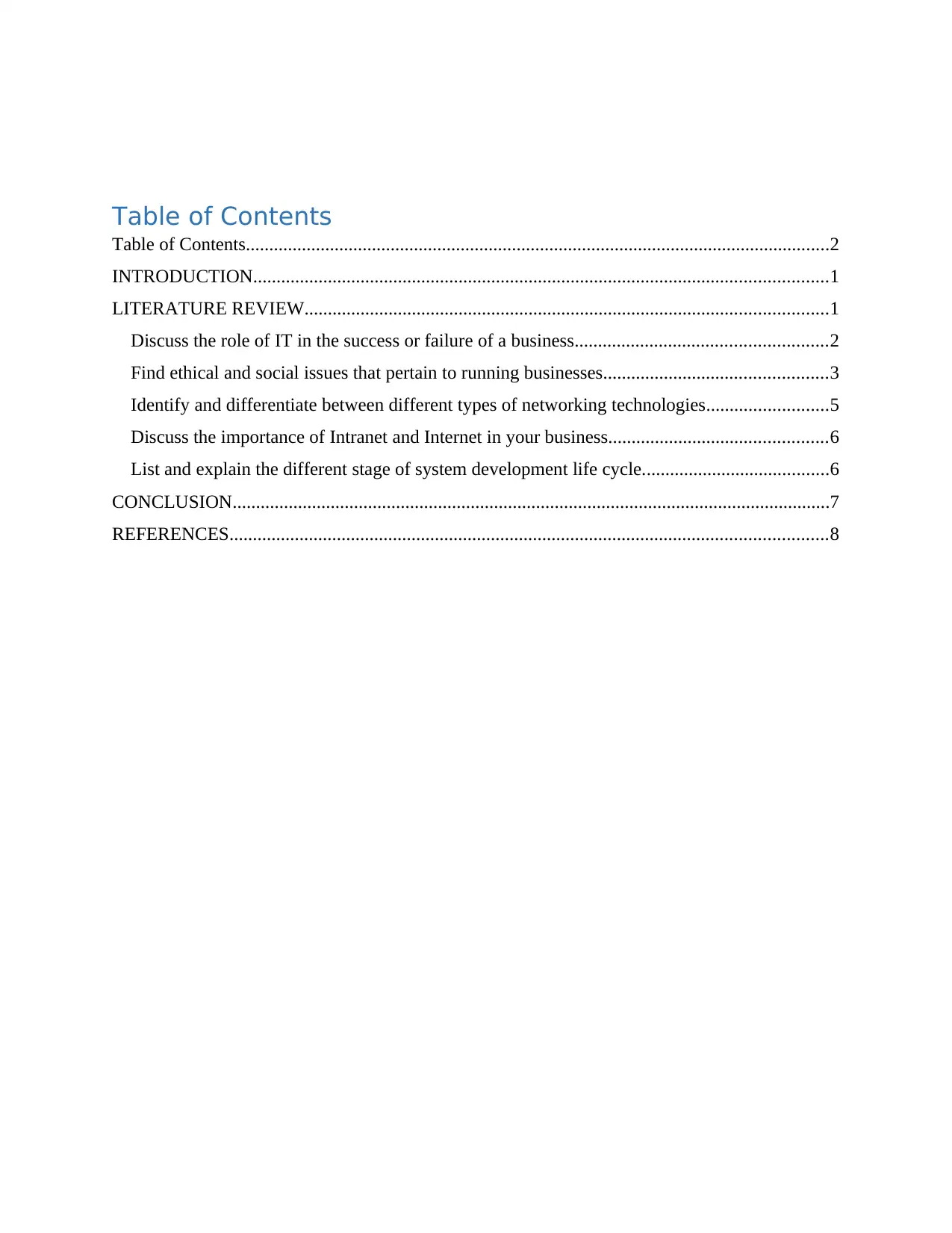
Table of Contents
Table of Contents.............................................................................................................................2
INTRODUCTION...........................................................................................................................1
LITERATURE REVIEW................................................................................................................1
Discuss the role of IT in the success or failure of a business......................................................2
Find ethical and social issues that pertain to running businesses................................................3
Identify and differentiate between different types of networking technologies..........................5
Discuss the importance of Intranet and Internet in your business...............................................6
List and explain the different stage of system development life cycle........................................6
CONCLUSION................................................................................................................................7
REFERENCES................................................................................................................................8
Table of Contents.............................................................................................................................2
INTRODUCTION...........................................................................................................................1
LITERATURE REVIEW................................................................................................................1
Discuss the role of IT in the success or failure of a business......................................................2
Find ethical and social issues that pertain to running businesses................................................3
Identify and differentiate between different types of networking technologies..........................5
Discuss the importance of Intranet and Internet in your business...............................................6
List and explain the different stage of system development life cycle........................................6
CONCLUSION................................................................................................................................7
REFERENCES................................................................................................................................8

⊘ This is a preview!⊘
Do you want full access?
Subscribe today to unlock all pages.

Trusted by 1+ million students worldwide
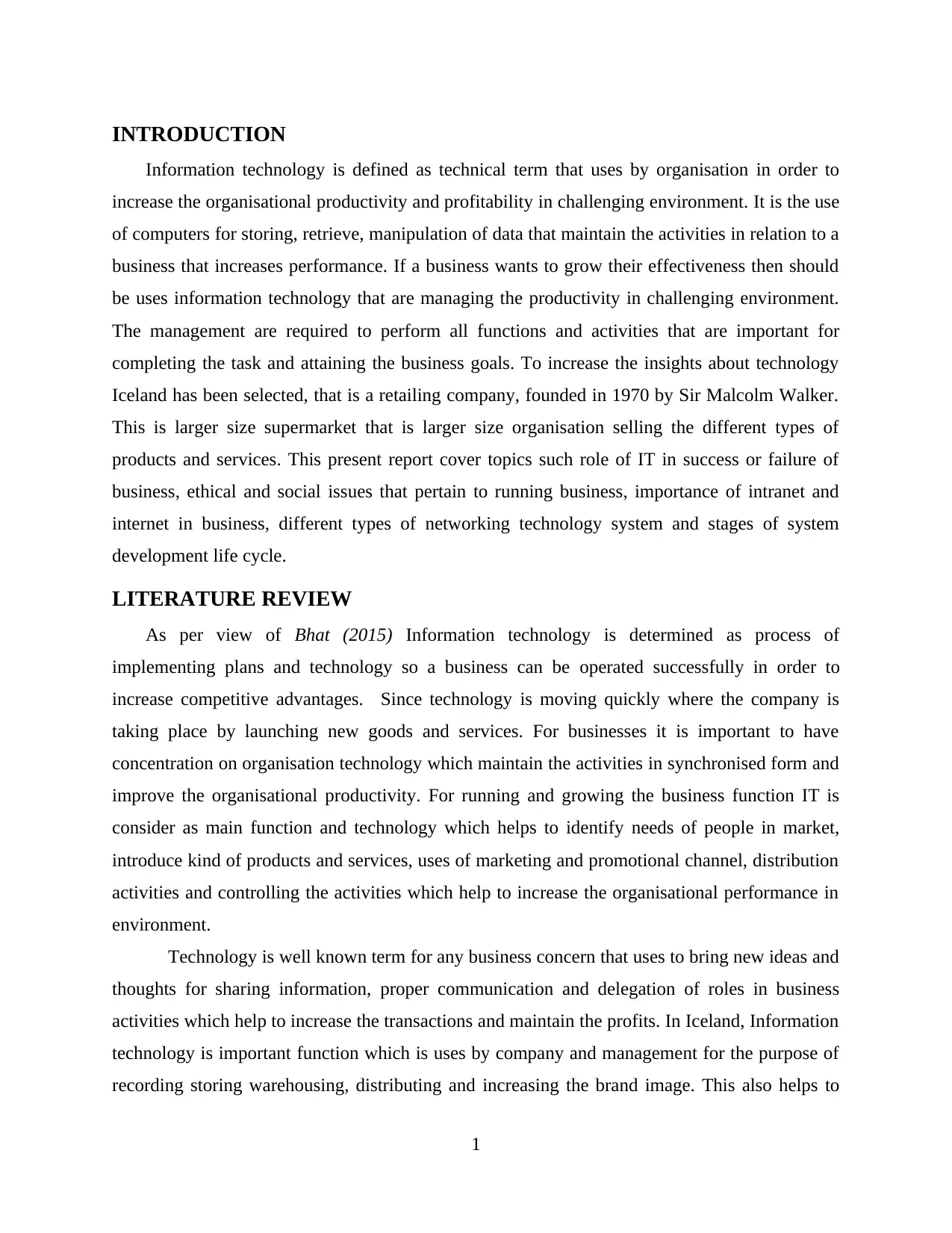
INTRODUCTION
Information technology is defined as technical term that uses by organisation in order to
increase the organisational productivity and profitability in challenging environment. It is the use
of computers for storing, retrieve, manipulation of data that maintain the activities in relation to a
business that increases performance. If a business wants to grow their effectiveness then should
be uses information technology that are managing the productivity in challenging environment.
The management are required to perform all functions and activities that are important for
completing the task and attaining the business goals. To increase the insights about technology
Iceland has been selected, that is a retailing company, founded in 1970 by Sir Malcolm Walker.
This is larger size supermarket that is larger size organisation selling the different types of
products and services. This present report cover topics such role of IT in success or failure of
business, ethical and social issues that pertain to running business, importance of intranet and
internet in business, different types of networking technology system and stages of system
development life cycle.
LITERATURE REVIEW
As per view of Bhat (2015) Information technology is determined as process of
implementing plans and technology so a business can be operated successfully in order to
increase competitive advantages. Since technology is moving quickly where the company is
taking place by launching new goods and services. For businesses it is important to have
concentration on organisation technology which maintain the activities in synchronised form and
improve the organisational productivity. For running and growing the business function IT is
consider as main function and technology which helps to identify needs of people in market,
introduce kind of products and services, uses of marketing and promotional channel, distribution
activities and controlling the activities which help to increase the organisational performance in
environment.
Technology is well known term for any business concern that uses to bring new ideas and
thoughts for sharing information, proper communication and delegation of roles in business
activities which help to increase the transactions and maintain the profits. In Iceland, Information
technology is important function which is uses by company and management for the purpose of
recording storing warehousing, distributing and increasing the brand image. This also helps to
1
Information technology is defined as technical term that uses by organisation in order to
increase the organisational productivity and profitability in challenging environment. It is the use
of computers for storing, retrieve, manipulation of data that maintain the activities in relation to a
business that increases performance. If a business wants to grow their effectiveness then should
be uses information technology that are managing the productivity in challenging environment.
The management are required to perform all functions and activities that are important for
completing the task and attaining the business goals. To increase the insights about technology
Iceland has been selected, that is a retailing company, founded in 1970 by Sir Malcolm Walker.
This is larger size supermarket that is larger size organisation selling the different types of
products and services. This present report cover topics such role of IT in success or failure of
business, ethical and social issues that pertain to running business, importance of intranet and
internet in business, different types of networking technology system and stages of system
development life cycle.
LITERATURE REVIEW
As per view of Bhat (2015) Information technology is determined as process of
implementing plans and technology so a business can be operated successfully in order to
increase competitive advantages. Since technology is moving quickly where the company is
taking place by launching new goods and services. For businesses it is important to have
concentration on organisation technology which maintain the activities in synchronised form and
improve the organisational productivity. For running and growing the business function IT is
consider as main function and technology which helps to identify needs of people in market,
introduce kind of products and services, uses of marketing and promotional channel, distribution
activities and controlling the activities which help to increase the organisational performance in
environment.
Technology is well known term for any business concern that uses to bring new ideas and
thoughts for sharing information, proper communication and delegation of roles in business
activities which help to increase the transactions and maintain the profits. In Iceland, Information
technology is important function which is uses by company and management for the purpose of
recording storing warehousing, distributing and increasing the brand image. This also helps to
1
Paraphrase This Document
Need a fresh take? Get an instant paraphrase of this document with our AI Paraphraser
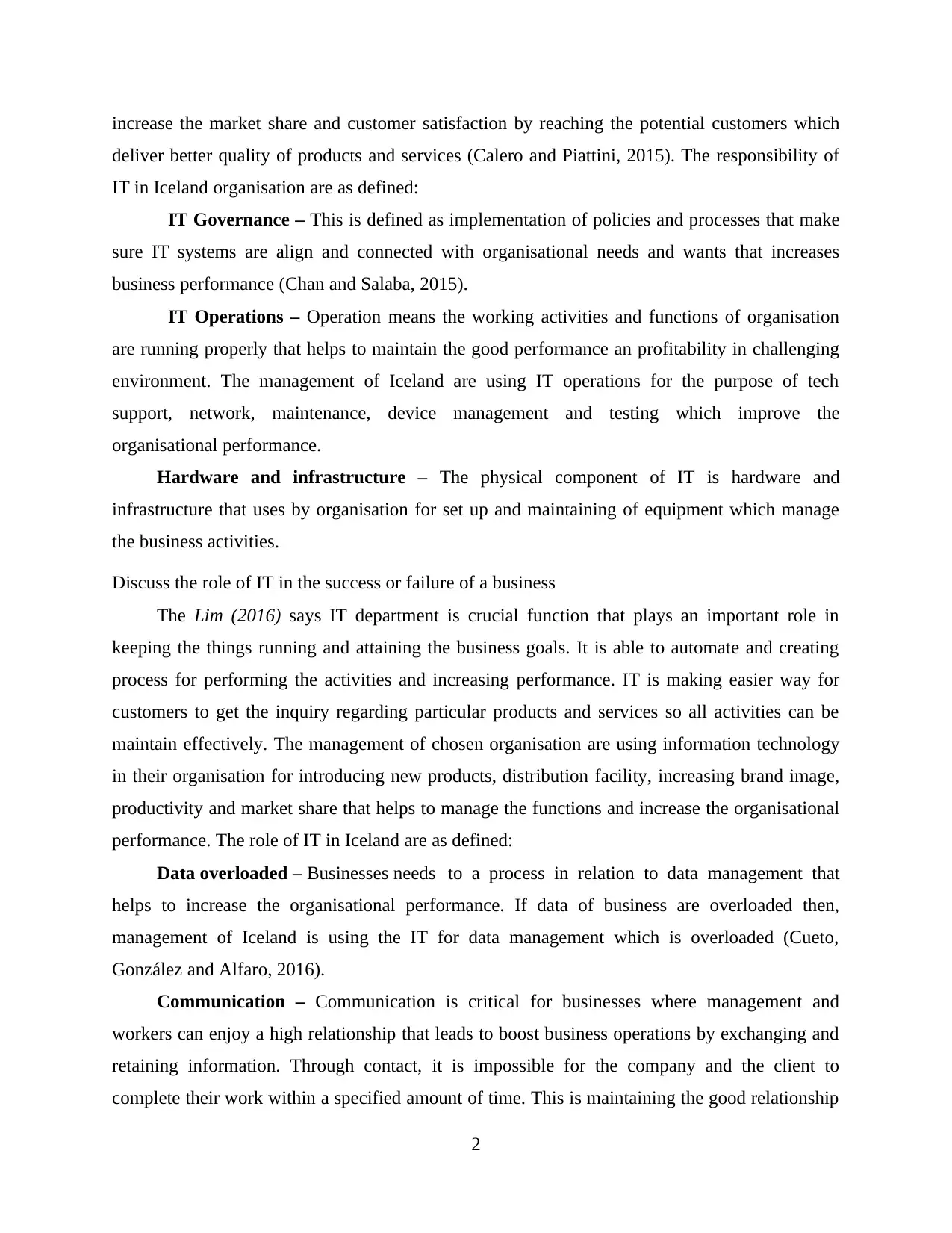
increase the market share and customer satisfaction by reaching the potential customers which
deliver better quality of products and services (Calero and Piattini, 2015). The responsibility of
IT in Iceland organisation are as defined:
IT Governance – This is defined as implementation of policies and processes that make
sure IT systems are align and connected with organisational needs and wants that increases
business performance (Chan and Salaba, 2015).
IT Operations – Operation means the working activities and functions of organisation
are running properly that helps to maintain the good performance an profitability in challenging
environment. The management of Iceland are using IT operations for the purpose of tech
support, network, maintenance, device management and testing which improve the
organisational performance.
Hardware and infrastructure – The physical component of IT is hardware and
infrastructure that uses by organisation for set up and maintaining of equipment which manage
the business activities.
Discuss the role of IT in the success or failure of a business
The Lim (2016) says IT department is crucial function that plays an important role in
keeping the things running and attaining the business goals. It is able to automate and creating
process for performing the activities and increasing performance. IT is making easier way for
customers to get the inquiry regarding particular products and services so all activities can be
maintain effectively. The management of chosen organisation are using information technology
in their organisation for introducing new products, distribution facility, increasing brand image,
productivity and market share that helps to manage the functions and increase the organisational
performance. The role of IT in Iceland are as defined:
Data overloaded – Businesses needs to a process in relation to data management that
helps to increase the organisational performance. If data of business are overloaded then,
management of Iceland is using the IT for data management which is overloaded (Cueto,
González and Alfaro, 2016).
Communication – Communication is critical for businesses where management and
workers can enjoy a high relationship that leads to boost business operations by exchanging and
retaining information. Through contact, it is impossible for the company and the client to
complete their work within a specified amount of time. This is maintaining the good relationship
2
deliver better quality of products and services (Calero and Piattini, 2015). The responsibility of
IT in Iceland organisation are as defined:
IT Governance – This is defined as implementation of policies and processes that make
sure IT systems are align and connected with organisational needs and wants that increases
business performance (Chan and Salaba, 2015).
IT Operations – Operation means the working activities and functions of organisation
are running properly that helps to maintain the good performance an profitability in challenging
environment. The management of Iceland are using IT operations for the purpose of tech
support, network, maintenance, device management and testing which improve the
organisational performance.
Hardware and infrastructure – The physical component of IT is hardware and
infrastructure that uses by organisation for set up and maintaining of equipment which manage
the business activities.
Discuss the role of IT in the success or failure of a business
The Lim (2016) says IT department is crucial function that plays an important role in
keeping the things running and attaining the business goals. It is able to automate and creating
process for performing the activities and increasing performance. IT is making easier way for
customers to get the inquiry regarding particular products and services so all activities can be
maintain effectively. The management of chosen organisation are using information technology
in their organisation for introducing new products, distribution facility, increasing brand image,
productivity and market share that helps to manage the functions and increase the organisational
performance. The role of IT in Iceland are as defined:
Data overloaded – Businesses needs to a process in relation to data management that
helps to increase the organisational performance. If data of business are overloaded then,
management of Iceland is using the IT for data management which is overloaded (Cueto,
González and Alfaro, 2016).
Communication – Communication is critical for businesses where management and
workers can enjoy a high relationship that leads to boost business operations by exchanging and
retaining information. Through contact, it is impossible for the company and the client to
complete their work within a specified amount of time. This is maintaining the good relationship
2
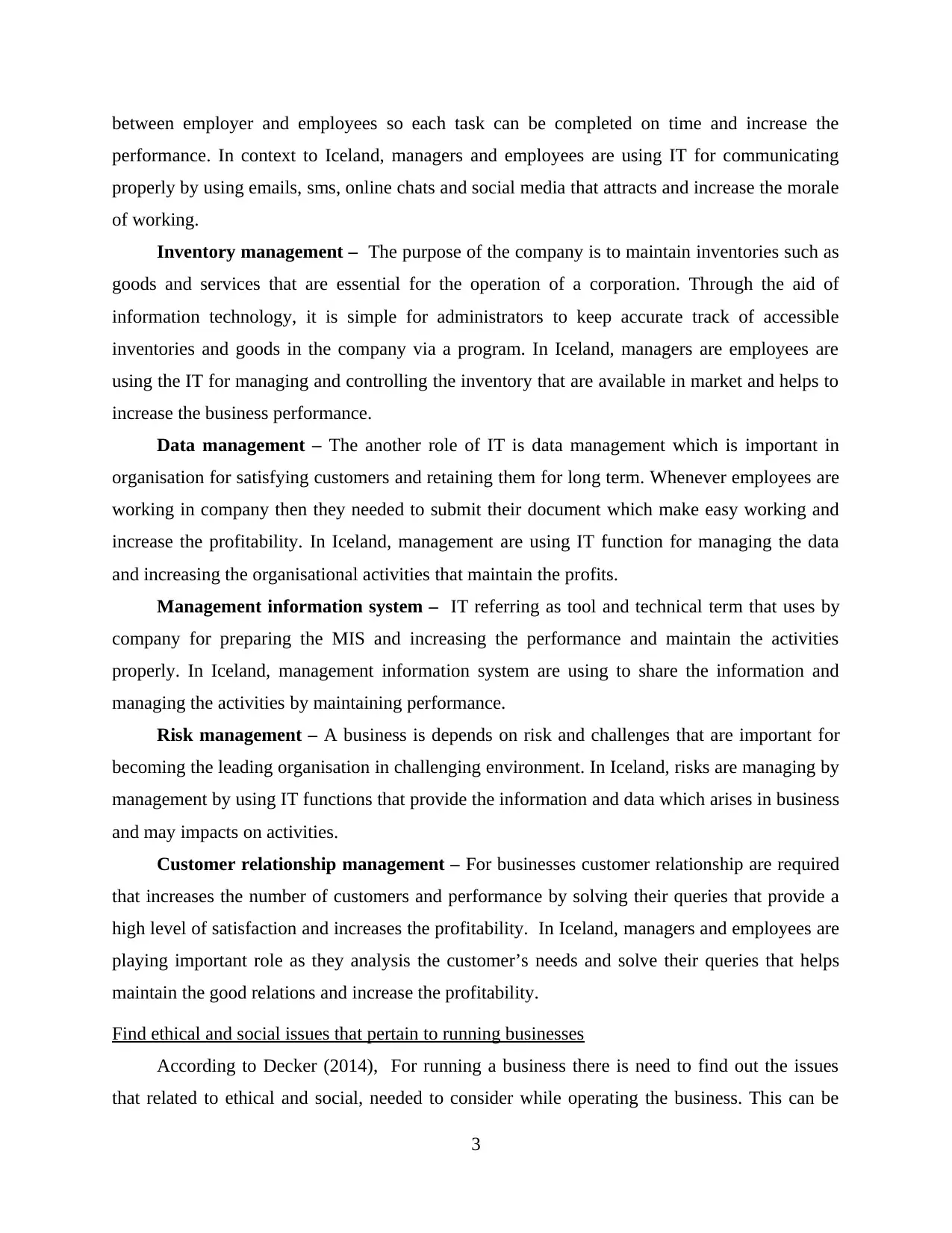
between employer and employees so each task can be completed on time and increase the
performance. In context to Iceland, managers and employees are using IT for communicating
properly by using emails, sms, online chats and social media that attracts and increase the morale
of working.
Inventory management – The purpose of the company is to maintain inventories such as
goods and services that are essential for the operation of a corporation. Through the aid of
information technology, it is simple for administrators to keep accurate track of accessible
inventories and goods in the company via a program. In Iceland, managers are employees are
using the IT for managing and controlling the inventory that are available in market and helps to
increase the business performance.
Data management – The another role of IT is data management which is important in
organisation for satisfying customers and retaining them for long term. Whenever employees are
working in company then they needed to submit their document which make easy working and
increase the profitability. In Iceland, management are using IT function for managing the data
and increasing the organisational activities that maintain the profits.
Management information system – IT referring as tool and technical term that uses by
company for preparing the MIS and increasing the performance and maintain the activities
properly. In Iceland, management information system are using to share the information and
managing the activities by maintaining performance.
Risk management – A business is depends on risk and challenges that are important for
becoming the leading organisation in challenging environment. In Iceland, risks are managing by
management by using IT functions that provide the information and data which arises in business
and may impacts on activities.
Customer relationship management – For businesses customer relationship are required
that increases the number of customers and performance by solving their queries that provide a
high level of satisfaction and increases the profitability. In Iceland, managers and employees are
playing important role as they analysis the customer’s needs and solve their queries that helps
maintain the good relations and increase the profitability.
Find ethical and social issues that pertain to running businesses
According to Decker (2014), For running a business there is need to find out the issues
that related to ethical and social, needed to consider while operating the business. This can be
3
performance. In context to Iceland, managers and employees are using IT for communicating
properly by using emails, sms, online chats and social media that attracts and increase the morale
of working.
Inventory management – The purpose of the company is to maintain inventories such as
goods and services that are essential for the operation of a corporation. Through the aid of
information technology, it is simple for administrators to keep accurate track of accessible
inventories and goods in the company via a program. In Iceland, managers are employees are
using the IT for managing and controlling the inventory that are available in market and helps to
increase the business performance.
Data management – The another role of IT is data management which is important in
organisation for satisfying customers and retaining them for long term. Whenever employees are
working in company then they needed to submit their document which make easy working and
increase the profitability. In Iceland, management are using IT function for managing the data
and increasing the organisational activities that maintain the profits.
Management information system – IT referring as tool and technical term that uses by
company for preparing the MIS and increasing the performance and maintain the activities
properly. In Iceland, management information system are using to share the information and
managing the activities by maintaining performance.
Risk management – A business is depends on risk and challenges that are important for
becoming the leading organisation in challenging environment. In Iceland, risks are managing by
management by using IT functions that provide the information and data which arises in business
and may impacts on activities.
Customer relationship management – For businesses customer relationship are required
that increases the number of customers and performance by solving their queries that provide a
high level of satisfaction and increases the profitability. In Iceland, managers and employees are
playing important role as they analysis the customer’s needs and solve their queries that helps
maintain the good relations and increase the profitability.
Find ethical and social issues that pertain to running businesses
According to Decker (2014), For running a business there is need to find out the issues
that related to ethical and social, needed to consider while operating the business. This can be
3
⊘ This is a preview!⊘
Do you want full access?
Subscribe today to unlock all pages.

Trusted by 1+ million students worldwide
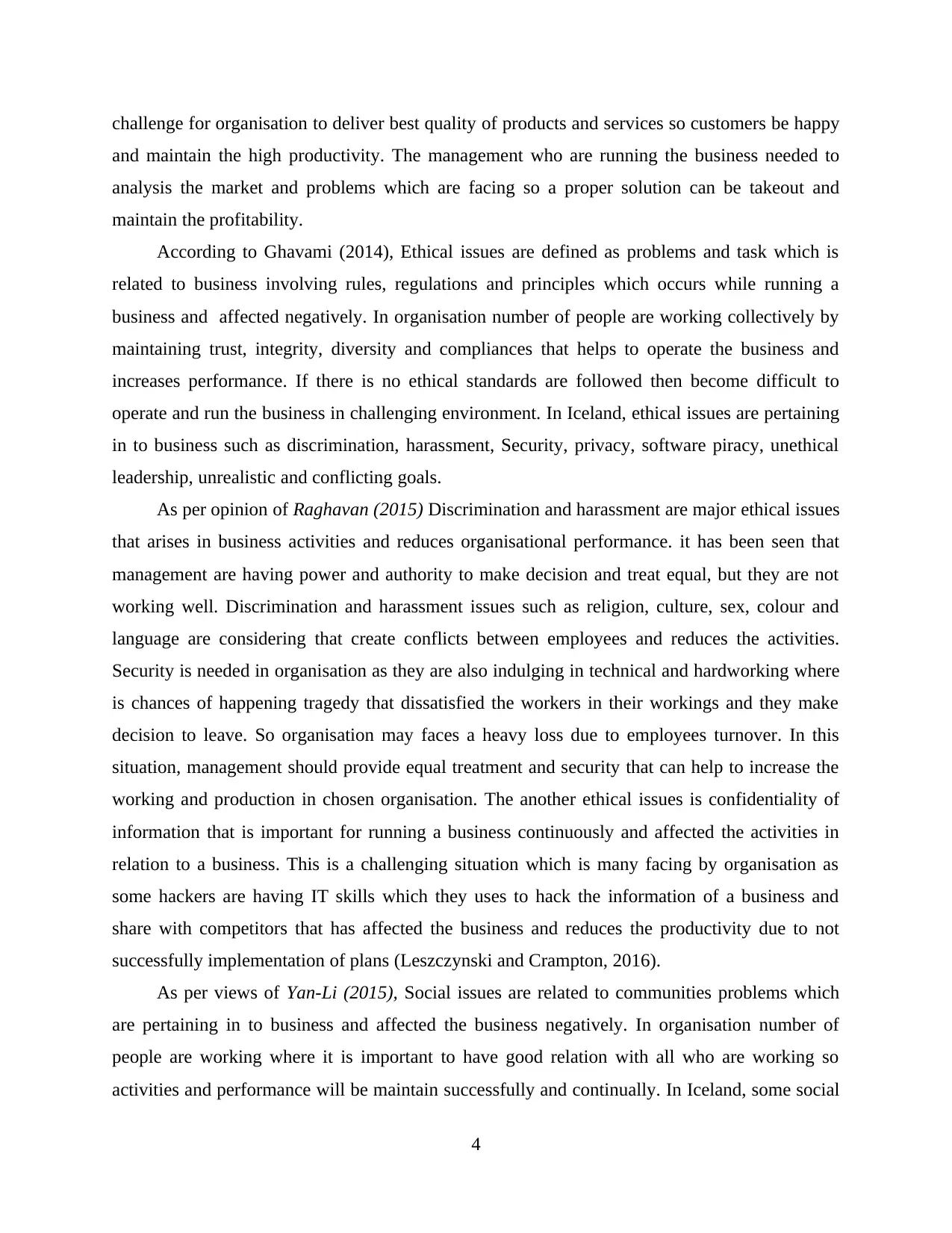
challenge for organisation to deliver best quality of products and services so customers be happy
and maintain the high productivity. The management who are running the business needed to
analysis the market and problems which are facing so a proper solution can be takeout and
maintain the profitability.
According to Ghavami (2014), Ethical issues are defined as problems and task which is
related to business involving rules, regulations and principles which occurs while running a
business and affected negatively. In organisation number of people are working collectively by
maintaining trust, integrity, diversity and compliances that helps to operate the business and
increases performance. If there is no ethical standards are followed then become difficult to
operate and run the business in challenging environment. In Iceland, ethical issues are pertaining
in to business such as discrimination, harassment, Security, privacy, software piracy, unethical
leadership, unrealistic and conflicting goals.
As per opinion of Raghavan (2015) Discrimination and harassment are major ethical issues
that arises in business activities and reduces organisational performance. it has been seen that
management are having power and authority to make decision and treat equal, but they are not
working well. Discrimination and harassment issues such as religion, culture, sex, colour and
language are considering that create conflicts between employees and reduces the activities.
Security is needed in organisation as they are also indulging in technical and hardworking where
is chances of happening tragedy that dissatisfied the workers in their workings and they make
decision to leave. So organisation may faces a heavy loss due to employees turnover. In this
situation, management should provide equal treatment and security that can help to increase the
working and production in chosen organisation. The another ethical issues is confidentiality of
information that is important for running a business continuously and affected the activities in
relation to a business. This is a challenging situation which is many facing by organisation as
some hackers are having IT skills which they uses to hack the information of a business and
share with competitors that has affected the business and reduces the productivity due to not
successfully implementation of plans (Leszczynski and Crampton, 2016).
As per views of Yan-Li (2015), Social issues are related to communities problems which
are pertaining in to business and affected the business negatively. In organisation number of
people are working where it is important to have good relation with all who are working so
activities and performance will be maintain successfully and continually. In Iceland, some social
4
and maintain the high productivity. The management who are running the business needed to
analysis the market and problems which are facing so a proper solution can be takeout and
maintain the profitability.
According to Ghavami (2014), Ethical issues are defined as problems and task which is
related to business involving rules, regulations and principles which occurs while running a
business and affected negatively. In organisation number of people are working collectively by
maintaining trust, integrity, diversity and compliances that helps to operate the business and
increases performance. If there is no ethical standards are followed then become difficult to
operate and run the business in challenging environment. In Iceland, ethical issues are pertaining
in to business such as discrimination, harassment, Security, privacy, software piracy, unethical
leadership, unrealistic and conflicting goals.
As per opinion of Raghavan (2015) Discrimination and harassment are major ethical issues
that arises in business activities and reduces organisational performance. it has been seen that
management are having power and authority to make decision and treat equal, but they are not
working well. Discrimination and harassment issues such as religion, culture, sex, colour and
language are considering that create conflicts between employees and reduces the activities.
Security is needed in organisation as they are also indulging in technical and hardworking where
is chances of happening tragedy that dissatisfied the workers in their workings and they make
decision to leave. So organisation may faces a heavy loss due to employees turnover. In this
situation, management should provide equal treatment and security that can help to increase the
working and production in chosen organisation. The another ethical issues is confidentiality of
information that is important for running a business continuously and affected the activities in
relation to a business. This is a challenging situation which is many facing by organisation as
some hackers are having IT skills which they uses to hack the information of a business and
share with competitors that has affected the business and reduces the productivity due to not
successfully implementation of plans (Leszczynski and Crampton, 2016).
As per views of Yan-Li (2015), Social issues are related to communities problems which
are pertaining in to business and affected the business negatively. In organisation number of
people are working where it is important to have good relation with all who are working so
activities and performance will be maintain successfully and continually. In Iceland, some social
4
Paraphrase This Document
Need a fresh take? Get an instant paraphrase of this document with our AI Paraphraser
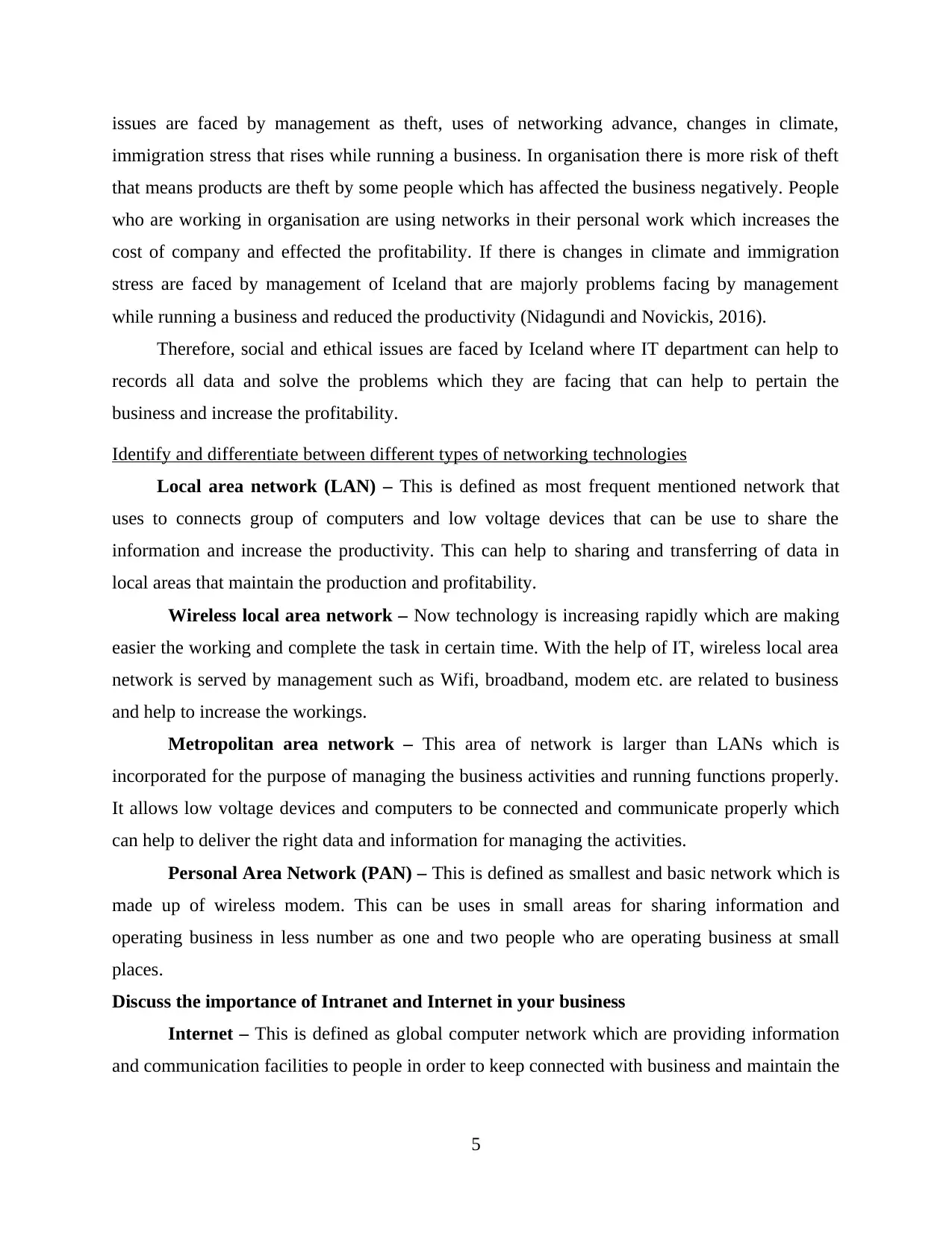
issues are faced by management as theft, uses of networking advance, changes in climate,
immigration stress that rises while running a business. In organisation there is more risk of theft
that means products are theft by some people which has affected the business negatively. People
who are working in organisation are using networks in their personal work which increases the
cost of company and effected the profitability. If there is changes in climate and immigration
stress are faced by management of Iceland that are majorly problems facing by management
while running a business and reduced the productivity (Nidagundi and Novickis, 2016).
Therefore, social and ethical issues are faced by Iceland where IT department can help to
records all data and solve the problems which they are facing that can help to pertain the
business and increase the profitability.
Identify and differentiate between different types of networking technologies
Local area network (LAN) – This is defined as most frequent mentioned network that
uses to connects group of computers and low voltage devices that can be use to share the
information and increase the productivity. This can help to sharing and transferring of data in
local areas that maintain the production and profitability.
Wireless local area network – Now technology is increasing rapidly which are making
easier the working and complete the task in certain time. With the help of IT, wireless local area
network is served by management such as Wifi, broadband, modem etc. are related to business
and help to increase the workings.
Metropolitan area network – This area of network is larger than LANs which is
incorporated for the purpose of managing the business activities and running functions properly.
It allows low voltage devices and computers to be connected and communicate properly which
can help to deliver the right data and information for managing the activities.
Personal Area Network (PAN) – This is defined as smallest and basic network which is
made up of wireless modem. This can be uses in small areas for sharing information and
operating business in less number as one and two people who are operating business at small
places.
Discuss the importance of Intranet and Internet in your business
Internet – This is defined as global computer network which are providing information
and communication facilities to people in order to keep connected with business and maintain the
5
immigration stress that rises while running a business. In organisation there is more risk of theft
that means products are theft by some people which has affected the business negatively. People
who are working in organisation are using networks in their personal work which increases the
cost of company and effected the profitability. If there is changes in climate and immigration
stress are faced by management of Iceland that are majorly problems facing by management
while running a business and reduced the productivity (Nidagundi and Novickis, 2016).
Therefore, social and ethical issues are faced by Iceland where IT department can help to
records all data and solve the problems which they are facing that can help to pertain the
business and increase the profitability.
Identify and differentiate between different types of networking technologies
Local area network (LAN) – This is defined as most frequent mentioned network that
uses to connects group of computers and low voltage devices that can be use to share the
information and increase the productivity. This can help to sharing and transferring of data in
local areas that maintain the production and profitability.
Wireless local area network – Now technology is increasing rapidly which are making
easier the working and complete the task in certain time. With the help of IT, wireless local area
network is served by management such as Wifi, broadband, modem etc. are related to business
and help to increase the workings.
Metropolitan area network – This area of network is larger than LANs which is
incorporated for the purpose of managing the business activities and running functions properly.
It allows low voltage devices and computers to be connected and communicate properly which
can help to deliver the right data and information for managing the activities.
Personal Area Network (PAN) – This is defined as smallest and basic network which is
made up of wireless modem. This can be uses in small areas for sharing information and
operating business in less number as one and two people who are operating business at small
places.
Discuss the importance of Intranet and Internet in your business
Internet – This is defined as global computer network which are providing information
and communication facilities to people in order to keep connected with business and maintain the
5
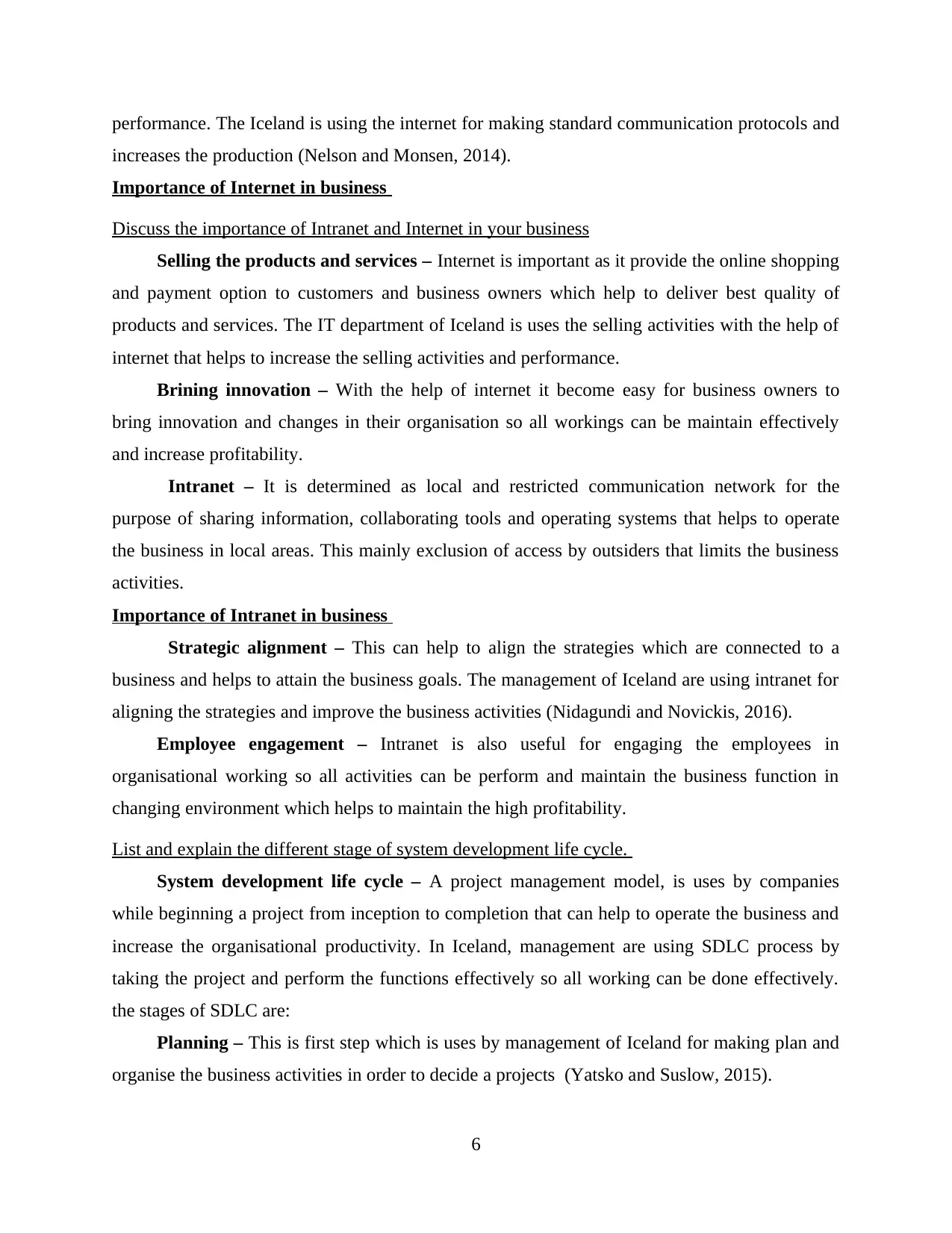
performance. The Iceland is using the internet for making standard communication protocols and
increases the production (Nelson and Monsen, 2014).
Importance of Internet in business
Discuss the importance of Intranet and Internet in your business
Selling the products and services – Internet is important as it provide the online shopping
and payment option to customers and business owners which help to deliver best quality of
products and services. The IT department of Iceland is uses the selling activities with the help of
internet that helps to increase the selling activities and performance.
Brining innovation – With the help of internet it become easy for business owners to
bring innovation and changes in their organisation so all workings can be maintain effectively
and increase profitability.
Intranet – It is determined as local and restricted communication network for the
purpose of sharing information, collaborating tools and operating systems that helps to operate
the business in local areas. This mainly exclusion of access by outsiders that limits the business
activities.
Importance of Intranet in business
Strategic alignment – This can help to align the strategies which are connected to a
business and helps to attain the business goals. The management of Iceland are using intranet for
aligning the strategies and improve the business activities (Nidagundi and Novickis, 2016).
Employee engagement – Intranet is also useful for engaging the employees in
organisational working so all activities can be perform and maintain the business function in
changing environment which helps to maintain the high profitability.
List and explain the different stage of system development life cycle.
System development life cycle – A project management model, is uses by companies
while beginning a project from inception to completion that can help to operate the business and
increase the organisational productivity. In Iceland, management are using SDLC process by
taking the project and perform the functions effectively so all working can be done effectively.
the stages of SDLC are:
Planning – This is first step which is uses by management of Iceland for making plan and
organise the business activities in order to decide a projects (Yatsko and Suslow, 2015).
6
increases the production (Nelson and Monsen, 2014).
Importance of Internet in business
Discuss the importance of Intranet and Internet in your business
Selling the products and services – Internet is important as it provide the online shopping
and payment option to customers and business owners which help to deliver best quality of
products and services. The IT department of Iceland is uses the selling activities with the help of
internet that helps to increase the selling activities and performance.
Brining innovation – With the help of internet it become easy for business owners to
bring innovation and changes in their organisation so all workings can be maintain effectively
and increase profitability.
Intranet – It is determined as local and restricted communication network for the
purpose of sharing information, collaborating tools and operating systems that helps to operate
the business in local areas. This mainly exclusion of access by outsiders that limits the business
activities.
Importance of Intranet in business
Strategic alignment – This can help to align the strategies which are connected to a
business and helps to attain the business goals. The management of Iceland are using intranet for
aligning the strategies and improve the business activities (Nidagundi and Novickis, 2016).
Employee engagement – Intranet is also useful for engaging the employees in
organisational working so all activities can be perform and maintain the business function in
changing environment which helps to maintain the high profitability.
List and explain the different stage of system development life cycle.
System development life cycle – A project management model, is uses by companies
while beginning a project from inception to completion that can help to operate the business and
increase the organisational productivity. In Iceland, management are using SDLC process by
taking the project and perform the functions effectively so all working can be done effectively.
the stages of SDLC are:
Planning – This is first step which is uses by management of Iceland for making plan and
organise the business activities in order to decide a projects (Yatsko and Suslow, 2015).
6
⊘ This is a preview!⊘
Do you want full access?
Subscribe today to unlock all pages.

Trusted by 1+ million students worldwide
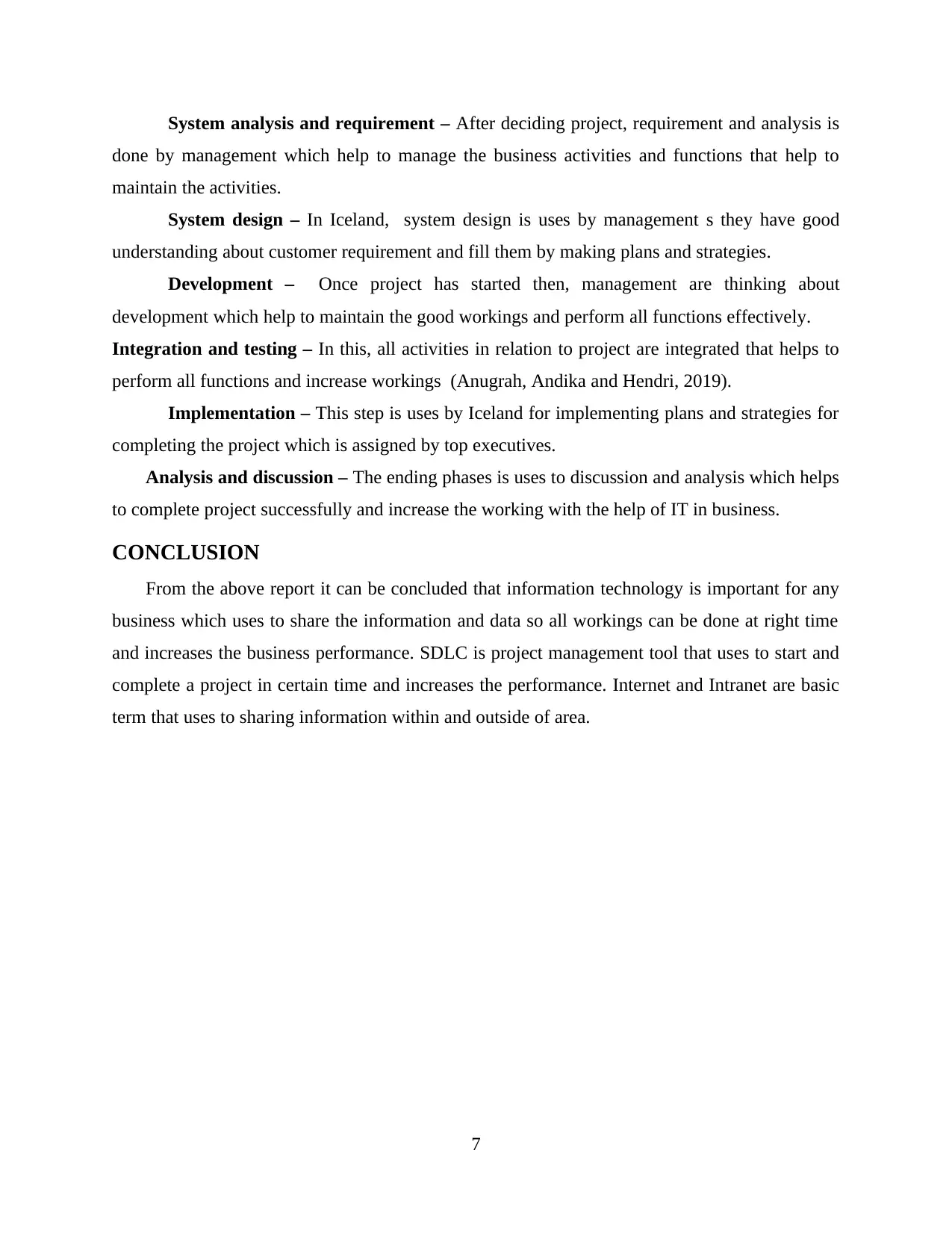
System analysis and requirement – After deciding project, requirement and analysis is
done by management which help to manage the business activities and functions that help to
maintain the activities.
System design – In Iceland, system design is uses by management s they have good
understanding about customer requirement and fill them by making plans and strategies.
Development – Once project has started then, management are thinking about
development which help to maintain the good workings and perform all functions effectively.
Integration and testing – In this, all activities in relation to project are integrated that helps to
perform all functions and increase workings (Anugrah, Andika and Hendri, 2019).
Implementation – This step is uses by Iceland for implementing plans and strategies for
completing the project which is assigned by top executives.
Analysis and discussion – The ending phases is uses to discussion and analysis which helps
to complete project successfully and increase the working with the help of IT in business.
CONCLUSION
From the above report it can be concluded that information technology is important for any
business which uses to share the information and data so all workings can be done at right time
and increases the business performance. SDLC is project management tool that uses to start and
complete a project in certain time and increases the performance. Internet and Intranet are basic
term that uses to sharing information within and outside of area.
7
done by management which help to manage the business activities and functions that help to
maintain the activities.
System design – In Iceland, system design is uses by management s they have good
understanding about customer requirement and fill them by making plans and strategies.
Development – Once project has started then, management are thinking about
development which help to maintain the good workings and perform all functions effectively.
Integration and testing – In this, all activities in relation to project are integrated that helps to
perform all functions and increase workings (Anugrah, Andika and Hendri, 2019).
Implementation – This step is uses by Iceland for implementing plans and strategies for
completing the project which is assigned by top executives.
Analysis and discussion – The ending phases is uses to discussion and analysis which helps
to complete project successfully and increase the working with the help of IT in business.
CONCLUSION
From the above report it can be concluded that information technology is important for any
business which uses to share the information and data so all workings can be done at right time
and increases the business performance. SDLC is project management tool that uses to start and
complete a project in certain time and increases the performance. Internet and Intranet are basic
term that uses to sharing information within and outside of area.
7
Paraphrase This Document
Need a fresh take? Get an instant paraphrase of this document with our AI Paraphraser
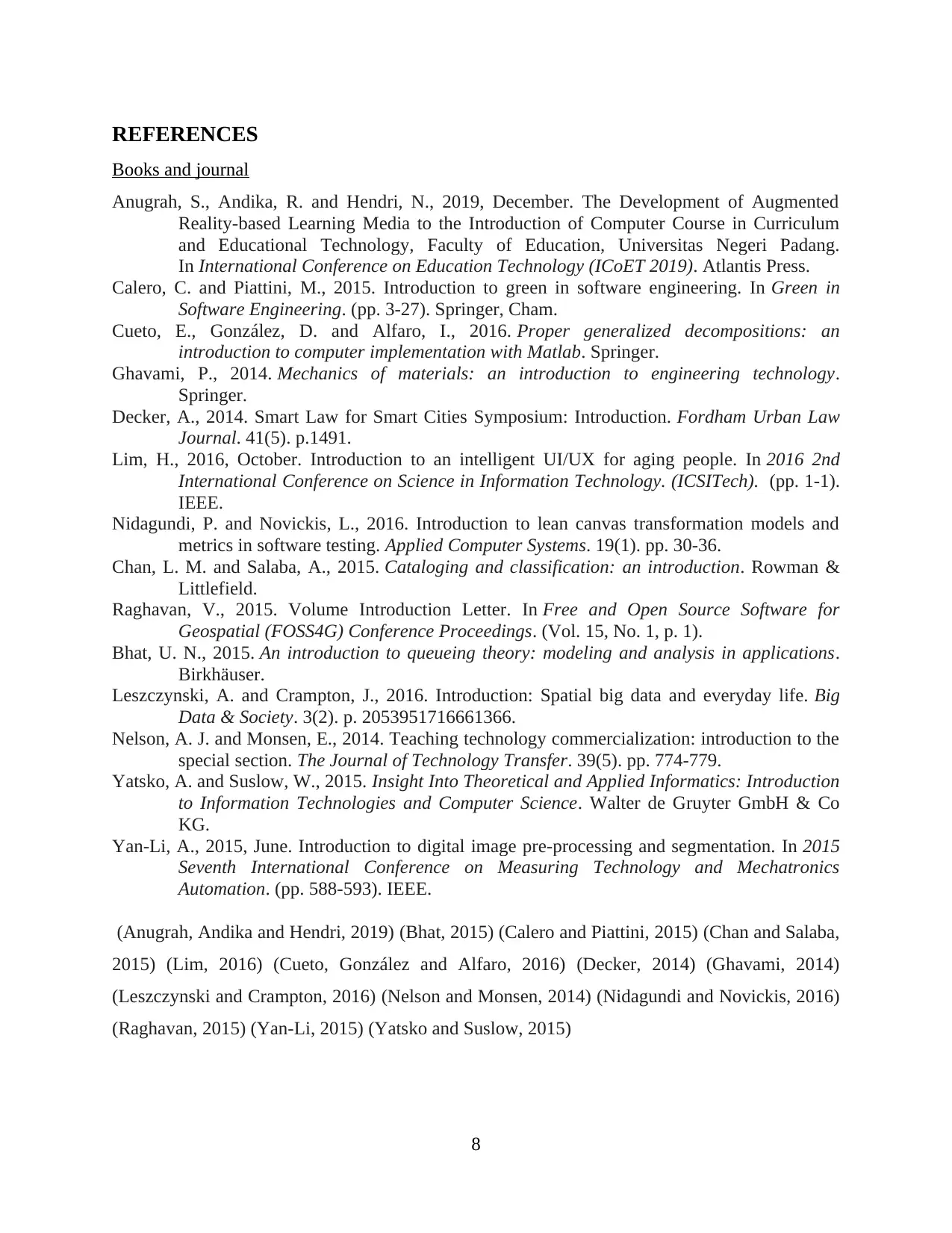
REFERENCES
Books and journal
Anugrah, S., Andika, R. and Hendri, N., 2019, December. The Development of Augmented
Reality-based Learning Media to the Introduction of Computer Course in Curriculum
and Educational Technology, Faculty of Education, Universitas Negeri Padang.
In International Conference on Education Technology (ICoET 2019). Atlantis Press.
Calero, C. and Piattini, M., 2015. Introduction to green in software engineering. In Green in
Software Engineering. (pp. 3-27). Springer, Cham.
Cueto, E., González, D. and Alfaro, I., 2016. Proper generalized decompositions: an
introduction to computer implementation with Matlab. Springer.
Ghavami, P., 2014. Mechanics of materials: an introduction to engineering technology.
Springer.
Decker, A., 2014. Smart Law for Smart Cities Symposium: Introduction. Fordham Urban Law
Journal. 41(5). p.1491.
Lim, H., 2016, October. Introduction to an intelligent UI/UX for aging people. In 2016 2nd
International Conference on Science in Information Technology. (ICSITech). (pp. 1-1).
IEEE.
Nidagundi, P. and Novickis, L., 2016. Introduction to lean canvas transformation models and
metrics in software testing. Applied Computer Systems. 19(1). pp. 30-36.
Chan, L. M. and Salaba, A., 2015. Cataloging and classification: an introduction. Rowman &
Littlefield.
Raghavan, V., 2015. Volume Introduction Letter. In Free and Open Source Software for
Geospatial (FOSS4G) Conference Proceedings. (Vol. 15, No. 1, p. 1).
Bhat, U. N., 2015. An introduction to queueing theory: modeling and analysis in applications.
Birkhäuser.
Leszczynski, A. and Crampton, J., 2016. Introduction: Spatial big data and everyday life. Big
Data & Society. 3(2). p. 2053951716661366.
Nelson, A. J. and Monsen, E., 2014. Teaching technology commercialization: introduction to the
special section. The Journal of Technology Transfer. 39(5). pp. 774-779.
Yatsko, A. and Suslow, W., 2015. Insight Into Theoretical and Applied Informatics: Introduction
to Information Technologies and Computer Science. Walter de Gruyter GmbH & Co
KG.
Yan-Li, A., 2015, June. Introduction to digital image pre-processing and segmentation. In 2015
Seventh International Conference on Measuring Technology and Mechatronics
Automation. (pp. 588-593). IEEE.
(Anugrah, Andika and Hendri, 2019) (Bhat, 2015) (Calero and Piattini, 2015) (Chan and Salaba,
2015) (Lim, 2016) (Cueto, González and Alfaro, 2016) (Decker, 2014) (Ghavami, 2014)
(Leszczynski and Crampton, 2016) (Nelson and Monsen, 2014) (Nidagundi and Novickis, 2016)
(Raghavan, 2015) (Yan-Li, 2015) (Yatsko and Suslow, 2015)
8
Books and journal
Anugrah, S., Andika, R. and Hendri, N., 2019, December. The Development of Augmented
Reality-based Learning Media to the Introduction of Computer Course in Curriculum
and Educational Technology, Faculty of Education, Universitas Negeri Padang.
In International Conference on Education Technology (ICoET 2019). Atlantis Press.
Calero, C. and Piattini, M., 2015. Introduction to green in software engineering. In Green in
Software Engineering. (pp. 3-27). Springer, Cham.
Cueto, E., González, D. and Alfaro, I., 2016. Proper generalized decompositions: an
introduction to computer implementation with Matlab. Springer.
Ghavami, P., 2014. Mechanics of materials: an introduction to engineering technology.
Springer.
Decker, A., 2014. Smart Law for Smart Cities Symposium: Introduction. Fordham Urban Law
Journal. 41(5). p.1491.
Lim, H., 2016, October. Introduction to an intelligent UI/UX for aging people. In 2016 2nd
International Conference on Science in Information Technology. (ICSITech). (pp. 1-1).
IEEE.
Nidagundi, P. and Novickis, L., 2016. Introduction to lean canvas transformation models and
metrics in software testing. Applied Computer Systems. 19(1). pp. 30-36.
Chan, L. M. and Salaba, A., 2015. Cataloging and classification: an introduction. Rowman &
Littlefield.
Raghavan, V., 2015. Volume Introduction Letter. In Free and Open Source Software for
Geospatial (FOSS4G) Conference Proceedings. (Vol. 15, No. 1, p. 1).
Bhat, U. N., 2015. An introduction to queueing theory: modeling and analysis in applications.
Birkhäuser.
Leszczynski, A. and Crampton, J., 2016. Introduction: Spatial big data and everyday life. Big
Data & Society. 3(2). p. 2053951716661366.
Nelson, A. J. and Monsen, E., 2014. Teaching technology commercialization: introduction to the
special section. The Journal of Technology Transfer. 39(5). pp. 774-779.
Yatsko, A. and Suslow, W., 2015. Insight Into Theoretical and Applied Informatics: Introduction
to Information Technologies and Computer Science. Walter de Gruyter GmbH & Co
KG.
Yan-Li, A., 2015, June. Introduction to digital image pre-processing and segmentation. In 2015
Seventh International Conference on Measuring Technology and Mechatronics
Automation. (pp. 588-593). IEEE.
(Anugrah, Andika and Hendri, 2019) (Bhat, 2015) (Calero and Piattini, 2015) (Chan and Salaba,
2015) (Lim, 2016) (Cueto, González and Alfaro, 2016) (Decker, 2014) (Ghavami, 2014)
(Leszczynski and Crampton, 2016) (Nelson and Monsen, 2014) (Nidagundi and Novickis, 2016)
(Raghavan, 2015) (Yan-Li, 2015) (Yatsko and Suslow, 2015)
8
1 out of 11
Related Documents
Your All-in-One AI-Powered Toolkit for Academic Success.
+13062052269
info@desklib.com
Available 24*7 on WhatsApp / Email
![[object Object]](/_next/static/media/star-bottom.7253800d.svg)
Unlock your academic potential
Copyright © 2020–2025 A2Z Services. All Rights Reserved. Developed and managed by ZUCOL.




